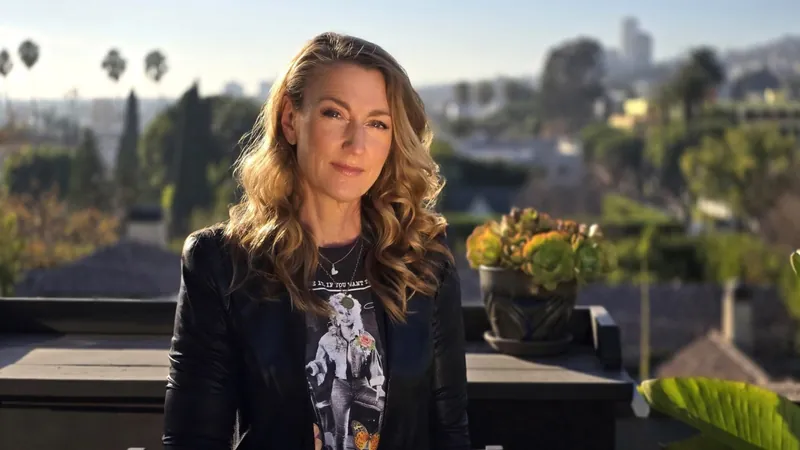
Norwegian Journalist Kjersti Flaa Breaks Silence Amidst Lively-Baldoni Legal Drama: “I’m Not Their Scapegoat!”
2025-01-03
Author: Kai
The Unexpected Player in a Hollywood Drama
In the ever-twisting saga between actress Blake Lively and director Justin Baldoni, an unexpected player has surfaced: Kjersti Flaa, a 51-year-old Norwegian entertainment journalist based in the U.S. Flaa has recently found herself entangled in a highly publicized feud that has led to lawsuits over harassment and defamation.
The Viral Moment
Flaa's involvement began in August when she shared a clip from a 2016 interview she conducted with Lively during the press tour for Woody Allen's *Café Society*. The interview, a painfully awkward four-minute exchange, instantly went viral after Flaa jokingly congratulated Lively on her pregnancy, only for Lively to curtly respond, “Congrats on your little bump,” referring to Flaa's non-existent pregnancy. This cringe-worthy moment resurfaced just as Baldoni's *It Ends With Us*, co-starring Lively, hit theaters, igniting speculation of discord between the two stars.
Flaa's Perspective
"I had no idea there was a controversy brewing when I posted the interview," Flaa insists in an exclusive interview. She explains that the decision to resurface the footage stemmed from a discussion with a Norwegian television colleague regarding Hollywood censorship. Previously hesitant to release the clip due to fears of being 'blacklisted,' Flaa saw this as an opportunity to share her experiences once she distanced herself from junket coverage during the COVID-19 pandemic.
The Backlash
However, Flaa's video became a flashpoint in the conflict, with online commentators using it as evidence against Lively, accusing her of being insincere about *It Ends With Us*, a film that tackles the serious subject of domestic violence—based on Colleen Hoover's bestselling novel. Critics argued that Lively was marketing the film in a tone-deaf manner, drawing connections to superficial branding efforts like promoting her hair care line.
Escalation of Tensions
Under mounting pressure from the backlash, Lively retaliated, accusing Baldoni and his production team of orchestrating a “coordinated smear campaign” against her. She claimed this was a form of retaliation for her allegations of misconduct on set. The situation escalated when The New York Times published a deep-dive article connecting Flaa’s video to this alleged smear campaign, further complicating the journalistic narrative.
Flaa's Denial of Conspiracy
Flaa has adamantly denied any involvement in a conspiracy against Lively, saying, "I was not contacted by Baldoni or Lively's teams before or after I posted the video." She feels that the fallout from her clip unfairly painted her as a villain, deflecting attention from Lively's actions during the interview itself.
Legal Developments
Baldoni's legal representatives have filed a $250 million defamation lawsuit against The New York Times, asserting that the article unfairly misrepresented their client and disregarded evidence that contradicted Lively's claims. While the outlet has stood by its reporting, Flaa feels its failure to seek her perspective has caused significant personal and professional damage.
Flaa's Reflection
She reflects, "It’s disheartening that my video, just an archive of my work, is being weaponized to serve someone else's narrative." Flaa believes the media narrative oversimplifies complex issues, contributing to a toxic atmosphere where celebrities and journalists navigate difficult waters.
Hope for Resolution
Though the drama appears to be relentless, Flaa remains hopeful for a fair resolution. She is waiting to hear both sides of the story in court before voicing her definitive stance on who may be at fault. "What’s happening online—people being judged on snippets without context—is dangerous," she notes, expressing concern over the rapid judgments that dominate social media discourse.
Flaa's Personal Journey
On a personal note, Flaa’s journey has been a steep learning curve within the cutthroat world of Hollywood. Despite the overwhelming negativity surrounding her, she has gained support through her YouTube channel, which has seen a surge in subscribers since the incident. Flaa now shares insights into her experiences as a journalist, while the awkward interactions she posts continue to captivate audiences.
Conclusion
"I may have become part of this strange narrative, but I want my work to speak for itself," she concludes. Whether she will pursue legal action against the Times remains open-ended, but Flaa is determined not to be a scapegoat in Hollywood's chaotic theatrics. One thing is certain: the drama unfolding between Lively, Baldoni, and Flaa encapsulates the harsh realities of fame and journalism in today's digital age.
 Brasil (PT)
Brasil (PT)
 Canada (EN)
Canada (EN)
 Chile (ES)
Chile (ES)
 Česko (CS)
Česko (CS)
 대한민국 (KO)
대한민국 (KO)
 España (ES)
España (ES)
 France (FR)
France (FR)
 Hong Kong (EN)
Hong Kong (EN)
 Italia (IT)
Italia (IT)
 日本 (JA)
日本 (JA)
 Magyarország (HU)
Magyarország (HU)
 Norge (NO)
Norge (NO)
 Polska (PL)
Polska (PL)
 Schweiz (DE)
Schweiz (DE)
 Singapore (EN)
Singapore (EN)
 Sverige (SV)
Sverige (SV)
 Suomi (FI)
Suomi (FI)
 Türkiye (TR)
Türkiye (TR)
 الإمارات العربية المتحدة (AR)
الإمارات العربية المتحدة (AR)